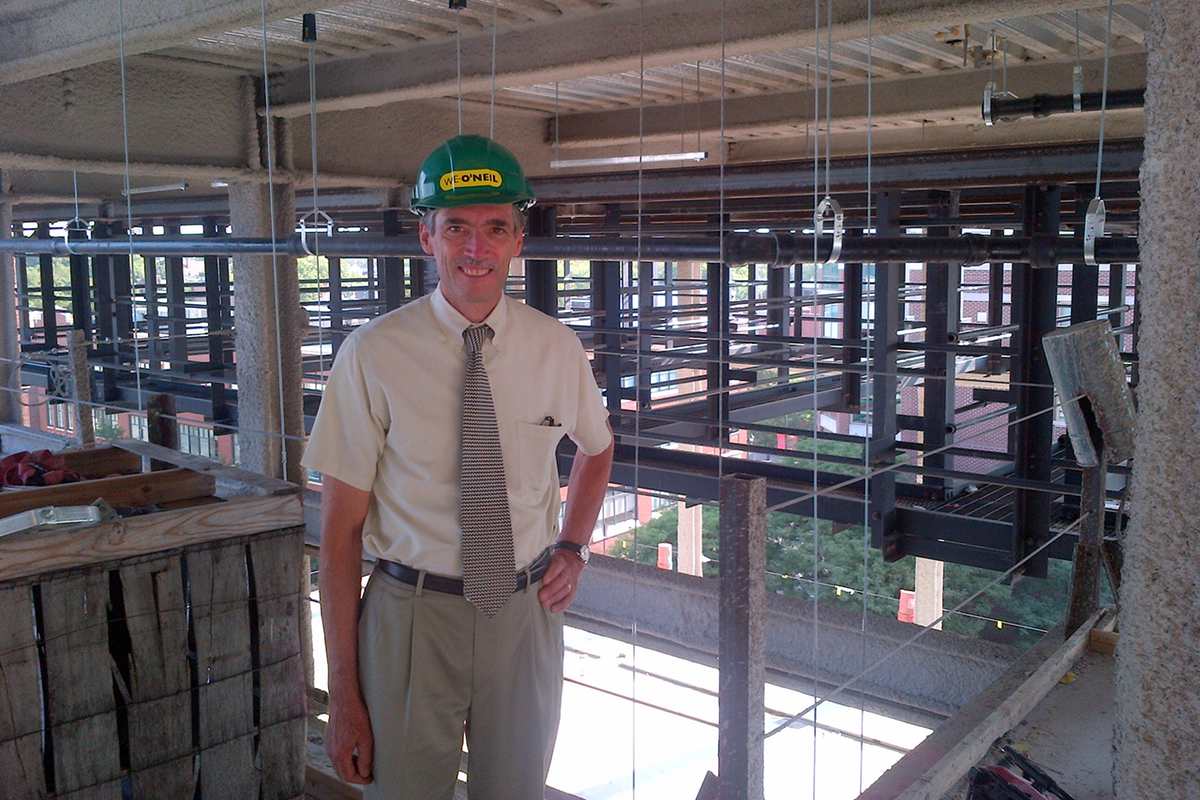 John Culbert in 2012, during construction of what would become The Theatre School's new facilities.
John Culbert in 2012, during construction of what would become The Theatre School's new facilities.
This month, to honor and reflect on the tenure of The Theatre School's dean, John Culbert, upon his retirement, we are highlighting some of the places and people of the school that are documented in
DePaul Special Collections and Archives.
In the May 10, 2001, news release announcing Culbert as dean, he emphasized new and improved facilities would be at the top of his agenda. "I will support new facilities that reflect the flagship conservatory status of the school, provide state-of-the-art training opportunities and performance venues, and enable us to challenge, entertain and stimulate the imagination of the university community, our city and the profession," he said.
His vision set the stage for what The Theatre School would achieve over the next 20 years.
 DePaul's 1989 production of "The Misanthrope," with scenery and lighting designed by Culbert, was the first show in the newly purchased Merle Reskin Theatre.
DePaul's 1989 production of "The Misanthrope," with scenery and lighting designed by Culbert, was the first show in the newly purchased Merle Reskin Theatre.
Culbert joined DePaul in 1988, as assistant professor and head of the Lighting Design program in The Theatre School. That same year, DePaul purchased the Blackstone Theatre in the Loop, saved the building from demolition, invested in its renovation, and eventually renamed it the Merle Reskin Theatre. The first production staged in the newly purchased theatre was "The Misanthrope," with scenery and lighting designed by Culbert. The Chicago Tribune reported: "DePaul also has made sure that the theatre's artistic content is at a high level for the reopening."
But while performances were taking place at the Reskin Theatre, The Theatre School's classrooms, rehearsal spaces, production studios, and offices were all on the Lincoln Park Campus, at 2135 and 2130 N. Kenmore Ave. The first strategic plan made for The Theatre School under Culbert in 2002 set objectives for a new facility that would function more efficiently and appropriately. The university made progress toward that goal, but not until the 2009 strategic plan did designing, building, and inhabiting a new facility become a key priority.
What Culbert set out to build would open in September 2013: two state-of-the-art theatre spaces, costume, makeup, prop and scene shops, rehearsal studios, lighting laboratories and movement studios. Culbert remarked on the benefits to the student experience upon the opening, saying, "I like to say we're putting the theatre back in The Theatre School."
Culbert's tenure as dean is defined not only by the notable new facilities at the corner of Fullerton and Racine. In that same May 10, 2001, news release, he also noted his plans "to provide a bridge between the professional community and the training school." He referenced the many alumni who achieved successful careers in theatre, film, and television, as well as the many faculty members directly involved in Chicago's dynamic theatre community. The combination of the two continues to provide countless opportunities for connections and hands-on learning for students.
In University Archives, we have several collections from alumni and faculty of The Theatre School that attest to those connections and serve as a resource for students and researchers. The collections document various generations of theatre, television, and film actors, directors, costume and set designers, and artists.
Among them are the papers of Nan Cibula-Jenkins, artist, costume designer, professor, and former head of costume design at The Theatre School. Her collection contains sketches, costume design drawings, clippings, fabric samples, photographs, programs, and notes. Cibula-Jenkins worked simultaneously with many local theatres, such as the Goodman Theatre, Steppenwolf Theatre, Chicago Shakespeare Theatre, and Court Theatre. As a teacher, she was known for offering her distinguished professional background to her students, providing them with real-life solutions to design issues. She also worked alongside Culbert on productions during their early years at DePaul and designed the costumes for "The Misanthrope" in 1989.
 Lois Nettleton's first Emmy Award, presented for her performance in "The American Woman: Portraits of Courage" (1976).
Lois Nettleton's first Emmy Award, presented for her performance in "The American Woman: Portraits of Courage" (1976).
The papers of alum Lois Nettleton, an actress from the Chicago area who had a long and varied career in theater, television, and film from 1949 to 2006, can also be found in University Archives. Her collection includes correspondence, press clippings, scripts with annotations, programs, photographs, and recordings of performances and TV appearances, as well as two Emmy Awards, for her performances in "The American Woman: Portraits of Courage" (1976) and "Insight: A Gun for Mandy" (1982-1983).
These collections are examples of the records in University Archives that serve to document the history of The Theatre School and the lives and work of its administration, faculty, staff, students, and alumni. They also serve as primary sources of information for researchers and students training in a conservatory setting.